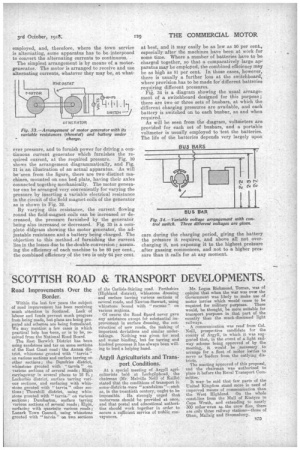SCOTTISH ROAD & TRANSPORT DEVELOPMENTS.
Page 19

If you've noticed an error in this article please click here to report it so we can fix it.
Road Improvements Over the Border.
Within the last few years the subject of road improvemenb has been receiving much attention in Scotland. Lack of labour and funds prevent much progress from being made, but plans are being prepared and schemes are being formulated. We may mention a few cases in which practical help has been, or is to be, received from the National Road Board.
The East Berwick District has been using sandstone and tar on some sections of the East Coast road ; the Annan dietrict, whinstone groeted with " tarvia " on various sections and surface tarring on other sections ; the Dumfries district, whinstone grouted with " tarvia " on various sections of several roads ; Elgin carriageway in several places to 18 ft. ; Lockerbie district, surface tarring various sections, and surfacing with whinstone grouted with " tarvia " other sections; Thornhill district, using whinstone grouted with " tarvia." on various sections ; Dumbarton, surface tarring various sections of several roads; Elgin,. surfacing with quartzite various roads; Lanark Town Council, using whinstone grouted with " Midis " on two sections of the Carlisle-Stirling road. Perthshire (Highland district), whinetone dressing and surface tarring various sections of several roads, and Newton-Stewart, using svhinstone bound with " rocmac " on various seetions.
Of course the Road Board never gave any assistance except fa substantial improvement in surface dressing, the construction` of new roads, the making of important deviations and similar undertakings. Nothing was given for mud and water binding, but for tarring and kindred processes it ha si always been willing to lend a helping hand.
Argyll Agriculturists and Transport Conditions.
At a special meeting of Argyll agriculturists held at Lochgilphead, the Chairman (Mr. Melville Neill of Keills) stated that the conditions of transport in some' districts -were "scandalous ' —such as, in the twentieth century, ought to be impossible. He strongly urged that motorvans should 'be provided at once, and that postal and educational authorities should work together in order to secure a sufficient service of public conveyances. '
Mr. Logan Richmond, Torran, was of opinion that when the war was over the Government was likely to make use of motor lorries which would cease to be required for military purposes. These would, he thought, be more suitable for transport purposes in that part of the country than the much-discussed light railways.
• A communication was read' from Col. Neill, prospective candidate for the county of Argyll, in which it was suggested that, in the event of a light railway scheme being approved of by the meeting, it would be necessary to arrange for a fleet of motor lorries to serve as feeders from the outlying districts.
The meeting approved of this proposal, end the chairman was authorized to place it before the Rural Transport Committee.
It may be said that few parts of the United Kingdom stand more in need of improved means of communication than the West Highland. On the whole coast-line from the Mull of Kintyre to Cape Wrath, and extending to nearly 300 miles-even as the crow flies, there are only three railway stations—those of Ohan, Mallaig and Stromeferry,






















